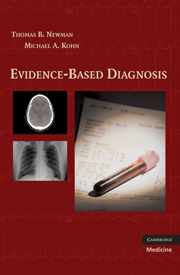Book contents
- Frontmatter
- Contents
- Preface
- Acknowledgments & Dedication
- Abbreviations/Acronyms
- 1 Introduction: understanding diagnosis and diagnostic testing
- 2 Reliability and measurement error
- 3 Dichotomous tests
- 4 Multilevel and continuous tests
- 5 Critical appraisal of studies of diagnostic tests
- 6 Screening tests
- 7 Prognostic tests and studies
- 8 Multiple tests and multivariable decision rules
- 9 Quantifying treatment effects using randomized trials
- 10 Alternatives to randomized trials for estimating treatment effects
- 11 Understanding P-values and confidence intervals
- 12 Challenges for evidence-based diagnosis
- Answers to problems
- Index
- References
3 - Dichotomous tests
Published online by Cambridge University Press: 04 August 2010
- Frontmatter
- Contents
- Preface
- Acknowledgments & Dedication
- Abbreviations/Acronyms
- 1 Introduction: understanding diagnosis and diagnostic testing
- 2 Reliability and measurement error
- 3 Dichotomous tests
- 4 Multilevel and continuous tests
- 5 Critical appraisal of studies of diagnostic tests
- 6 Screening tests
- 7 Prognostic tests and studies
- 8 Multiple tests and multivariable decision rules
- 9 Quantifying treatment effects using randomized trials
- 10 Alternatives to randomized trials for estimating treatment effects
- 11 Understanding P-values and confidence intervals
- 12 Challenges for evidence-based diagnosis
- Answers to problems
- Index
- References
Summary
Introduction
In this chapter and the next, we move from assessing test reliability (reproducibility) to assessing accuracy. We are no longer comparing repeated administrations of an imperfect test or comparing one imperfect test with another; we are comparing the test result to the patient's true disease state (D+ or D−) in order to quantify how often the test gives the right answer. This requires that we have a “gold standard” (also known as “reference standard”) against which to compare our test. In this chapter, we introduce these concepts with dichotomous tests. In Chapter 4, we extend the discussion to multilevel and continuous tests.
Sensitivity, specificity, prevalence, predictive value, and accuracy
We will review the definitions of sensitivity, specificity, prevalence, predictive value and accuracy using as an example the evaluation of a rapid bedside test for influenza virus reported by Poehling et al. (2002). Simplifying somewhat, the study compared results of a rapid bedside test for influenza called QuickVue with the true influenza status in children hospitalized with fever or respiratory symptoms. The authors used as a gold standard for diagnosing influenza either a positive viral culture or two positive polymerase chain reaction tests. We present the data using just the polymerase chain reaction test results as the gold standard. The results were as shown in Table 3.1.
- Type
- Chapter
- Information
- Evidence-Based Diagnosis , pp. 39 - 67Publisher: Cambridge University PressPrint publication year: 2009
References
- 3
- Cited by



